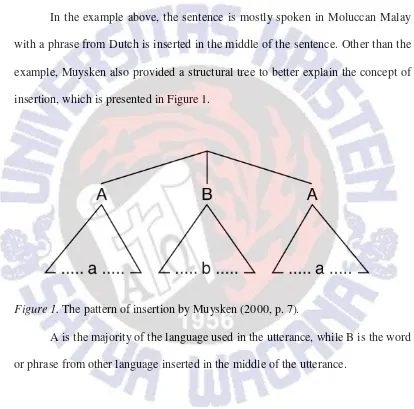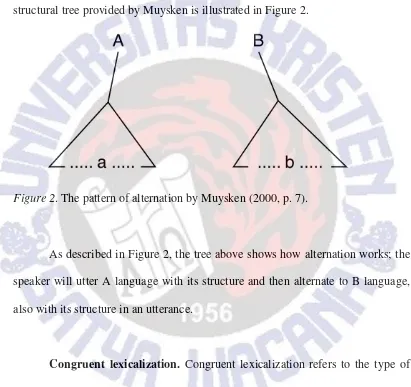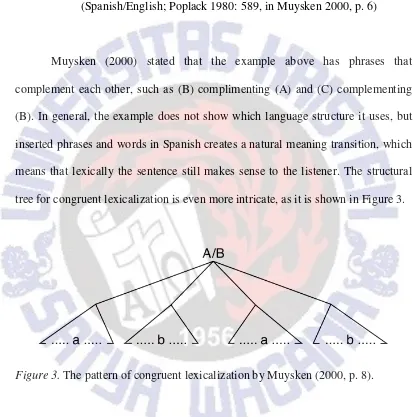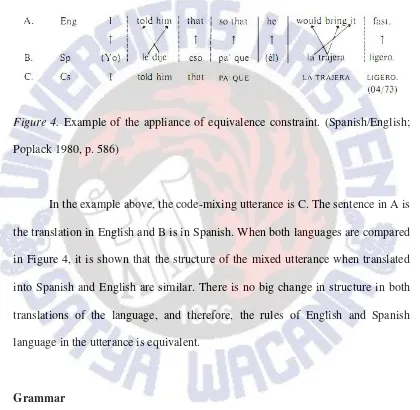4
Review of Literature
Sociolinguistics
Sociolinguistics study, as stated by Holmes (2013) focuses on the relationship between language and society, examining why people speak in a different way in different social context. Wardhaugh (2006) described the sociolinguistics study by looking into the definition of language and society one by one: any group of people is a society, and language is what the people in the society speak. When the people in this society communicate, they use a certain language that they understand. Each society has their own language to speak, and how they communicate from one society to another is also different. Holmes (2013) also explained further that the way people speak in a variety of social contexts gives away how they share information in one context to another, and through the study of sociolinguistics all of those aspects can be explored.
Bilingualism in Indonesia
-5
mixing being more often than not. The code-mixing phenomenon involves mixing two or more languages in a single sentence; therefore, the probability of code-mixing occurring among Indonesia people is high.
Code-Mixing
Code-mixing, derived from the use of the term ‘code’ by Wardhaugh (2006), is used to refer to anything that includes dialect, language, style, standard language, pidgin, and creole; therefore, code-mixing is a phenomenon when any of those types of code are mixed together when producing a sentence. Code-mixing shall not be confused with code-switching, which focuses on alternating between two or more languages in one conversation (Auer, 1998). If code-switching focuses on one conversation, code-mixing focuses on one sentence, particularly the lexical items and grammatical features from two or more languages (Muysken, 2000). Therefore, the difference between code-switching and code-mixing lies in the range of codes.
6
mother’s conversation in both Serbian and English, showing that any code-switch and code-mix of language is influenced by a lack of knowledge on vocabulary. This is more evident on the boy than the mother, showing that age plays an important factor in proficiency as well. Moradi and Gupta (2014) sum it up as code-mixing happens more among bilinguals with less knowledge in both languages than the more balanced ones. However, they also stated that “language competence is merely one factor regarding patterns of switching and code-mixing” (p. 284), which means that there are still chances that regardless of
proficiency, all bilinguals can still utilize code-mixing to each of a certain degree.
Types of Code-Mixing
There are many ways to determine whether a sentence is a mixed one or not. To determine this, there needs to be categorization of code-mixing, This research utilizes the categorization by Muysken (2000), who divided code-mixing into three categories: insertion, alternation, and congruent lexicalization.
Insertion. Insertion is the type of code-mixing where a word or a phrase from a language is inserted into a sentence in another language.
kalau dong tukan bikin dong tukan bikin (when they always make what they make)
voor acht personen dek orang cuma nganga dong makan
7
‘When they [cook], it is always for eight people, and then they only
look at it, they eat . . .’
(Moluccan Malay/Dutch; Huwaë 1992, in Muysken 2000, p.4)
[image:4.595.99.513.214.623.2]In the example above, the sentence is mostly spoken in Moluccan Malay with a phrase from Dutch is inserted in the middle of the sentence. Other than the example, Muysken also provided a structural tree to better explain the concept of insertion, which is presented in Figure 1.
Figure 1. The pattern of insertion by Muysken (2000, p. 7).
A is the majority of the language used in the utterance, while B is the word or phrase from other language inserted in the middle of the utterance.
Alternation. Alternation is the type of code-mixing where the language alternate in a sentence, which involves both grammar and lexicon. For example:
8
(French/Russian, Timm 1978, p.312, in Muysken 2000, p.5)
[image:5.595.100.511.221.608.2]In the example above, the language alternate only within the clauses from French to Russian (the Russian, therefore it is still considered a sentence. The structural tree provided by Muysken is illustrated in Figure 2.
Figure 2. The pattern of alternation by Muysken (2000, p. 7).
As described in Figure 2, the tree above shows how alternation works; the speaker will utter A language with its structure and then alternate to B language, also with its structure in an utterance.
9
(A) Why make Carol sentarse atrás (=sit at the back) (B) pa’que
(=so that) everybody has to move (C) pa’que se salga. (=so that
[she] may get out.)
(Spanish/English; Poplack 1980: 589, in Muysken 2000, p. 6)
[image:6.595.98.512.197.614.2]Muysken (2000) stated that the example above has phrases that complement each other, such as (B) complimenting (A) and (C) complementing (B). In general, the example does not show which language structure it uses, but inserted phrases and words in Spanish creates a natural meaning transition, which means that lexically the sentence still makes sense to the listener. The structural tree for congruent lexicalization is even more intricate, as it is shown in Figure 3.
Figure 3. The pattern of congruent lexicalization by Muysken (2000, p. 8).
10 Constraints on Code-Mixing
In code-mixing, there are also constraints that can be present in utterances. Poplack (1980) suggested two types of syntactic constraints that can be present in code-mixing, free morpheme constraint and equivalence constraint.
The free morpheme constraint, according to Poplack (1980) is the type of constraint where in an utterance only the free morpheme can experience code-mixing and bound morpheme stays the same. For example:
Eat-iendo (eating)
(Spanish/English; Poplack 1980, p. 586)
In the example above, Poplack (1980) explained that “–iendo” is a suffix, therefore considered a bound morpheme in Spanish. “Eat”, being a free morpheme
in English, had “-ing” initially as its suffix, but then it is replaced by “–iendo”, but the combination of “eat” and “–iendo” still retains the same meaning, which is “eating”. “Eat” can be replaced by another free morpheme that functions as a verb
in English or in Spanish, but “–iendo” stays the same, only to be replaced by “– ing” which has the same meaning of function in this example.
11
rule of either language, i.e. at points around which the surface structures of the two languages map onto each other.” (p. 586) This constraint provides a simple
rule that any code-mixing occurrence that happens within an utterance must not violate any rules that belong to the languages used in that one utterance.
Figure 4. Example of the appliance of equivalence constraint. (Spanish/English;
Poplack 1980, p. 586)
In the example above, the code-mixing utterance is C. The sentence in A is the translation in English and B is in Spanish. When both languages are compared in Figure 4, it is shown that the structure of the mixed utterance when translated into Spanish and English are similar. There is no big change in structure in both translations of the language, and therefore, the rules of English and Spanish language in the utterance is equivalent.
Grammar
[image:8.595.100.520.219.629.2]12
One of the most noticable differences between Indonesian and English grammar is the use of reduplication, which is considered a mechanism in forming words that can be based on many factors, including morphology, phonology, syntax, and semantics (Chaer, 2008). While in English this is not a common practice, it is commonly used in Indonesian for many purposes, and it can be applied to nouns, verbs, and adjectives. For example:
Berlari-lari
(Indonesian; Muslich 2010, p. 50)
This is one of the examples of reduplicated verb in Indonesian. When translated into English, the meaning becomes ‘running around, while ‘lari’ means ‘running’. Therefore, reduplication in this case can create additional meaning to
the word (Chaer, 2008). Other examples on reduplication are:
Hitam-hitam
Gedung-gedung
(Indonesian; Muslich 2010, p. 50)
‘Hitam-hitam’ is an example of reduplicated adjective. In this case, ‘hitam’
13
reduplicated noun, which means ‘buildings’, while ‘gedung’ means ‘a building’. This means that the nominal value of a word can be duplicated by using reduplication (Muslich, 2010).
Also, there are prefixes which can create either active or passive voice. While in English, one can form a sentence simply with subject followed by verb to create active voice (Jespersen, 2003), Sneddon (2006) proposed ‘me-’ and ‘nge-’ attached in front of verbs to create active voice in Indonesian. For example:
Mereka membeli pakaian di toko murah itu. ‘They bought clothes in that cheap shop.’
(Indonesian/English; Djenar 2003, p. 68) Kakak saya ngajar piano tiap hari.
‘My older sister/brother teaches piano every day.’
(Indonesian/English; Sneddon 2006, p.581)
14
Other than active form, there is also passive form. In English, passive voice is formed using auxillary words, such as ‘be’, ‘get’, or ‘become’ (Jespersen, 2003), but in Indonesian, it is formed with the use of prefix ‘di-’ attached before a
verb (Muslich, 2010). For example:
anak kecil umur dua atau tiga tahun, eh itu dibuang sama orangtuanya …
‘a young child of two or three years, eh … is thrown out
by its parents…’
(Indonesian/English; Sneddon 2003, p.531)
In the example of passive voice, the verb ‘buang’ follows right after the subject, which is ‘itu’. However, there is the prefix ‘di-’ attached before the verb, and it is equivalent to the auxillary ‘be’ in English, as is used in the translation, ‘is thrown out’, and it is in passive voice. Therefore, ‘di-’ attached to ‘buang’



